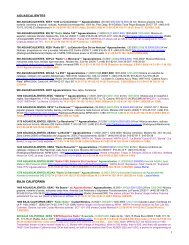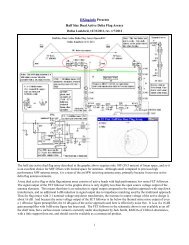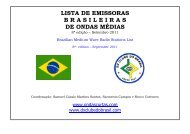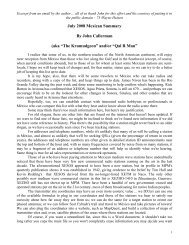The Icom IC-746Pro (IC-7400) Written by Bjarne Mjelde ... - DXing.info
The Icom IC-746Pro (IC-7400) Written by Bjarne Mjelde ... - DXing.info
The Icom IC-746Pro (IC-7400) Written by Bjarne Mjelde ... - DXing.info
You also want an ePaper? Increase the reach of your titles
YUMPU automatically turns print PDFs into web optimized ePapers that Google loves.
<strong>The</strong> <strong>Icom</strong> <strong>IC</strong>-<strong>746Pro</strong> (<strong>IC</strong>-<strong>7400</strong>)<br />
<strong>Written</strong> <strong>by</strong> <strong>Bjarne</strong> <strong>Mjelde</strong>, Norway<br />
(c) <strong>Bjarne</strong> <strong>Mjelde</strong>, www.kongsfjord.no<br />
This article is a follow-up of Dallas Lankford's article <strong>Icom</strong> <strong>IC</strong>-746 Pro: Impressions and Mods,<br />
published on www.kongsfjord.no and (partially) in the Swedish Short Wave Bulletin. For those who<br />
have not read it, and do not plan to read it, here is the micro version: Excellent filters, no uP crud,<br />
outstanding AM performance. But crippled MW and LW sensitivity, and disabled Preamp on MW.<br />
3 filter choices (though SSB/CW can be set to your own preferences, AM can't). Dallas modified<br />
the receiver (doing non-trivial mods) to full MW and LW sensitivity, and enabling Preamp 1 on<br />
MW. This resulted in AM, 6kHz, 30% modulation sensitivity of around 0.6uV on MW.<br />
Since Dallas Lankford mainly dealt with the technical<br />
aspect of the receiver, I will try to deal with the MW<br />
DX-er's aspect. I can do that since I am now the<br />
owner of the first <strong>IC</strong>-<strong>746Pro</strong> that Dallas modified.<br />
Please keep in mind that I am dealing with the <strong>746Pro</strong><br />
ONLY as a MW and SW RECEIVER. I am not<br />
interested in the transmitter part of it – and it should<br />
be noted for those unfamiliar with the transceiver that<br />
it has a serious reliability problem with its<br />
transmitter. Details can be found on the web.<br />
So then. My <strong>Icom</strong> <strong>IC</strong>-<strong>746Pro</strong> Receiver has a<br />
sensitivity of 0.6uV in the MW band (preamp 1 fixed on, preamp 2 not available on MW). My filter<br />
settings are 9.8/6.8/3.4 kHz on AM (nominally 9, 6 and 3 kHz), and 3.6/2.8/2.2 kHz on SSB. AGC<br />
release times on AM are 0.3/3.0/5.0 seconds (factory default being 3/5/7 seconds). I am a MW DXer<br />
(most of the time), I<br />
live in an RFI clean<br />
environment in the<br />
Arctic, and I have<br />
experience with other<br />
DSP receivers, the<br />
Kneisner & Doering<br />
KWZ-30 and the JRC<br />
NRD-545. Other<br />
receivers in my shack<br />
include two JRC NRD-<br />
525's, one Racal<br />
RA6790/GM, one <strong>Icom</strong><br />
<strong>IC</strong>-R75 (Kiwamodified)<br />
and one EAC<br />
R-390A (manufactured<br />
in 1967).<br />
AM performance: Like Dallas mentioned in his article, the <strong>746Pro</strong> has an AM synchronous<br />
detector which is totally transparent and which never loses lock. AM audio clarity and quality is<br />
excellent. Most important for a DX-er is that even if there are more than one signal on the<br />
frequency (for instance when monitoring a North American local channel like 1240), the receiver<br />
should be able to resolve the audio for not only one station, but as many as possible. Some radios<br />
are good at this. Some are not. Based on what I've heard so far, the <strong>746Pro</strong> is good at this. <strong>The</strong> 9<br />
kHz bandwidth is somewhat on the wide side. <strong>The</strong> ideal setting might have been 3.4/4.5/6,8 kHz.
<strong>The</strong>re is no 4.5 kHz bandwidth but it is not a<br />
major concern. <strong>The</strong> bandwidths are exceptionally<br />
good at rejecting signals from outside of the<br />
passband – quite contrary to (partially) the KWZ-<br />
30 and (especially) the NRD-545. <strong>The</strong> 3 kHz<br />
(nominal) can be used for DX-ing quite tight<br />
splits, though of course it can't compete with using<br />
SSB (ECSS) when interference is really tough. I<br />
have not yet encountered really tough selective<br />
fading which could challenge the AM sync<br />
detector, but from my experience so far, it clearly<br />
out-performs the Kiwa-modded sync detector in<br />
the <strong>IC</strong>-R75 and my other receivers, in that distortion seems to be almost totally gone.<br />
SSB (ECSS) performance: <strong>The</strong> three selected bandwidths suit me fine. Some may find 3.6 kHz as<br />
the upper SSB limit a downside – I don't. Anyway, if you can make do with 3.6 kHz or less as the<br />
"Wide" SSB (ECSS) filter, you can configure the<br />
three bandwidths to your liking – but unlike the<br />
NRD-545 there is no continous bandwidth<br />
control (BWC). Or so I thought. But there is!<br />
Because the twin PBT actually works as a<br />
continous bandwidth control. Analogue <strong>Icom</strong><br />
sets (like the <strong>IC</strong>-R75) use the 9 Mhz and the 455<br />
kHz IF for their passband tuning. Apparently,<br />
the <strong>746Pro</strong> continues in the <strong>Icom</strong> tradition, as the<br />
Twin PBT controls look exactly like those on the<br />
R75. Illusion. <strong>The</strong> Twin PBT function is pure<br />
mathematics, and works like this: Tuning one<br />
control right and the other control equally left<br />
reduces the bandwidth. It doesn't matter which<br />
control you tune to the right, as long as you tune<br />
the other the same number of Hz to the left. To find out if this was real bandwidth reduction, I<br />
chose the 3.6 bandwidth and reduced it to 2.8 <strong>by</strong> turning one control clockwide, the other<br />
counterclockwise. I then enganged the 2.8 bandwidth. Audio and interference was identical. <strong>The</strong>re<br />
was absolutely no difference. Tuning both one way engages IF shift. And then there are endless<br />
variations of reducing the bandwidth AND moving the passband. <strong>The</strong> manual could be more<br />
<strong>info</strong>rmative about how the controls work. In fact, one who is used to <strong>Icom</strong> equipment, could be left<br />
with the impression that this function is not much more than a traditional PBT.<br />
Like with AM, the SSB (ECSS) bandwidths do a superb job in reducing splatter from near<strong>by</strong><br />
stations – see Dallas' article for details.<br />
<strong>The</strong> SSB (ECSS) bandwidths can be set to SHARP or SOFT. In the SHARP setting, speech clarity<br />
is enhanced, while SOFT reduces the audible impact of noise (static, splatter etc) somewhat. <strong>The</strong><br />
correct setting will have to depend on how conditions are. Personally, after using SOFT for a while,<br />
I settled for SHARP as the default setting. <strong>The</strong> NRD-545 has a similar function (SHARP and<br />
LOOSE).<br />
I find the audio quality in SSB (ECSS) mode to be very good, bordering on excellent. <strong>The</strong> receiver<br />
is very stable from stock, it is not likely that one will observe differences in LSB and USB audio on<br />
MW and low-frequency SW frequencies. Mine is equipped with the high-stability option, and<br />
similar results were noted on the 15 Mhz range. Neither the KWZ-30, nor the NRD-545 could<br />
match this, in fact my NRD-545 was way off already on 12 Mhz (at least 20 Hz).
Of course, part of why the audio quality in my opinion is outstanding on this receiver, is the<br />
possibility of adjusting treble and bass +/- 5dB, so one can adjust audio quality to one's liking.<br />
Personally I like a touch of bass if the frequencies aren't too crowded and signal levels are OK. No<br />
problem with the <strong>746Pro</strong>.<br />
Display: While not in the league of the 756Pro and later, it is large and <strong>info</strong>rmative. Light and<br />
contrast can be adjusted. <strong>The</strong> frequency displays in large digits, which seems to be typically <strong>Icom</strong>.<br />
<strong>The</strong> two Menu lines and five function buttons seem to be well chosen. At first I missed continuous<br />
<strong>info</strong>rmation on bandwidths and PBT offsets (they do display as "pop-ups" when the controls are<br />
used, but disappear very quickly, and the filters only display as "Filter 1" etc). But if I press the<br />
"Filter" button for a second, all that <strong>info</strong>rmation is displayed, including the "real" filter bandwidth<br />
after adjusting the PBT's.<br />
<strong>The</strong> display also has a "scope" function which<br />
makes a graphic display of a smaller or larger<br />
part of the band below and above the selected<br />
frequency. I haven't been able to explore this<br />
well enough. However, if choosing low<br />
resolution (and thus large frequency spans) like<br />
10 or 20 kHz, the graphic display becomes<br />
inaccurate, in that low level (but perfectly<br />
readable) signals are not displayed. Even when<br />
using 1 or 5 kHz resolution, I was able to find<br />
audible signals not visible on the scope. So,<br />
using the display as a search function only will<br />
cause neglectance of the weakest stations (which<br />
for the most part are the ones we are looking for,<br />
right?).<br />
Interference rejection: Apart from the IF bandwidths, there are three tools, the Noise Blanker (NB),<br />
Noise Reduction (NR) and Notch Filter (NF – Auto which kills up to three tones simultanously, and<br />
Manual which kills one down to 70dB at 50 Hz bandwidth).<br />
I have not had any instances yet where I needed the NB. I have a Loran C station near<strong>by</strong> which can<br />
cause a lot of trouble if I get poor connections on the coax feeds or transformers that match my<br />
beverage antennas. So far during my ownership of the <strong>746Pro</strong> it hasn't happened. That said, my <strong>IC</strong>-<br />
R75 has had to face the Loran C noise a couple of times, and its NB has handled the noise<br />
admirably. I don't expect the <strong>746Pro</strong> NB to do any worse.<br />
Nor have I had the need to engange the NR. However, I have noted that adding a small amount of<br />
NR does enhance a weak AM signal, pulling it out of the mud so to speak (or possibly more exact;<br />
removing the mud).<br />
I wonder if the auto-notch feature may be an audio-notch. In AM mode, it decreased, but did not<br />
remove, a rather modest tone. It may not work well in AM compared to SSB for all I know. My<br />
experience with the <strong>IC</strong>-R75 is that the (audio) notch filter does work in AM, but not as well as in<br />
SSB. <strong>The</strong> manual notch is quite a different matter. It is definately an IF Notch. So you don't only<br />
notch out tones, you even notch out stations. Say (from my European perspective) you're on 1520<br />
trying to separate a US station from a strong European on 1521. You would obviously choose to<br />
use LSB and a rather narrow filter; still there would be a lot of interference. Engange manual notch,<br />
and use it to remove the carrier from the European station. It actually works! Of course it doesn't<br />
"remove the station" – what a wonderful tool that would be – but it reduces the interference level <strong>by</strong><br />
a considerable amount.<br />
Memories: Yes, I would have liked to store all MW frequencies in memory, like I could with the
NRD-545. With only 100 memory positions available, I can't. Still, the tuning step options of the<br />
<strong>746Pro</strong> do allow me to scan the MW band quite effectively, using a 10 kHz step when DX-ing the<br />
Americas, and a 9 kHz step when DX-ing Europe or Asia. <strong>The</strong> R75 is identical in this respect. So,<br />
scanning the MW is rather straightforward. Also, selecting the appropriate tuning steps to higher or<br />
lower resolution is easy – and more intuitive than on the NRD-545.<br />
Getting the weak stations: As I mentioned in the beginning of this article, my <strong>746Pro</strong> is measured at<br />
0.6uV on MW. My NRD-525's are in the 0.4 – 0.5uV range. My R-390A is not measured, but<br />
from usage I'd say it's around 0.5uV (which is where a well-aligned R-390A should be. Mine is<br />
well-aligned). <strong>The</strong> R75 (with Preamp 1 engaged) roughly equals the <strong>746Pro</strong>. Those are numbers.<br />
What about real life? Comparing the <strong>746Pro</strong> with the R-390A and the 525's, I do note that the latter<br />
radios are able to resolve an up-coming signal earlier than the <strong>746Pro</strong> (and the R75). However,<br />
when the signal begins to approach readable levels, there is no difference. So, in real life, there is<br />
no signal I can hear with the R-390A and the NRD-525's that I can't hear with the <strong>746Pro</strong> (and the<br />
R75).<br />
Conclusion: Located in an area where MW transmitters are very far away (and only one stable<br />
groundwave signal, on 657 with a signal level of around S9+10, depending on antenna), sensitivity<br />
is extremely important. A stock <strong>746Pro</strong> with its crippled MW and LW, and non-working preamp on<br />
MW, would be useless here even if all other properties of the receiver were outstanding. After<br />
Dallas Lankford modified it to correct specifications, it is indeed a superb receiver for MW DX. I<br />
haven't tested it much on SW, but I do not expect it to perform any worse on SW DX-ing than it<br />
does on MW.









